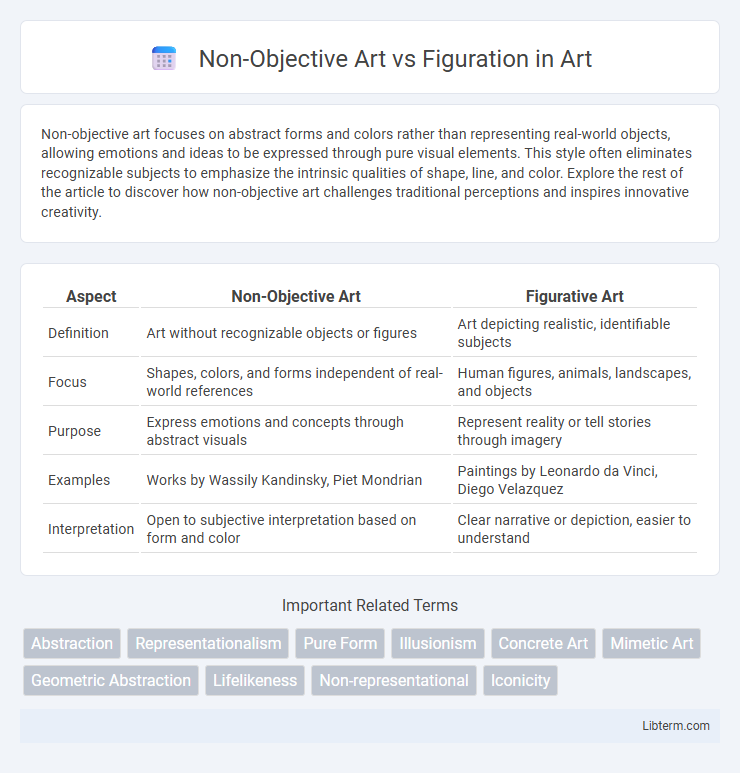Non-objective art focuses on abstract forms and colors rather than representing real-world objects, allowing emotions and ideas to be expressed through pure visual elements. This style often eliminates recognizable subjects to emphasize the intrinsic qualities of shape, line, and color. Explore the rest of the article to discover how non-objective art challenges traditional perceptions and inspires innovative creativity.
Table of Comparison
| Aspect | Non-Objective Art | Figurative Art |
|---|---|---|
| Definition | Art without recognizable objects or figures | Art depicting realistic, identifiable subjects |
| Focus | Shapes, colors, and forms independent of real-world references | Human figures, animals, landscapes, and objects |
| Purpose | Express emotions and concepts through abstract visuals | Represent reality or tell stories through imagery |
| Examples | Works by Wassily Kandinsky, Piet Mondrian | Paintings by Leonardo da Vinci, Diego Velazquez |
| Interpretation | Open to subjective interpretation based on form and color | Clear narrative or depiction, easier to understand |
Introduction to Non-Objective Art and Figuration
Non-objective art emphasizes abstract forms free from recognizable subjects, prioritizing color, shape, and line to evoke emotion and conceptual ideas rather than depicting reality. Figuration, by contrast, centers on representing real-world objects, people, or scenes, often aiming for recognizable and relatable imagery. Understanding these foundational approaches highlights the distinction between art driven by pure abstraction and art anchored in observable forms.
Historical Origins of Both Movements
Non-objective art originated in the early 20th century as artists like Wassily Kandinsky and Kazimir Malevich sought to break away from representational forms, emphasizing pure abstraction and spiritual expression through color and shape. Figuration, rooted in ancient artistic traditions, maintained a focus on representing real-world subjects and human figures, evolving through Renaissance masters such as Leonardo da Vinci and Michelangelo who refined realistic depiction techniques. The divergence between non-objective art and figuration crystallized during the 1910s and 1920s, reflecting broader cultural shifts towards modernism and the exploration of inner experience versus external reality.
Defining the Key Characteristics
Non-objective art emphasizes abstract forms, colors, and shapes without representing real-world objects, focusing on pure artistic expression and emotional impact. Figuration centers on recognizable subjects, depicting human figures, landscapes, or objects with an emphasis on realism and narrative content. Key characteristics of non-objective art include lack of representational reference and emphasis on composition and color harmony, while figuration relies on detailed representation and contextual storytelling.
Influential Artists in Non-Objective Art
Non-objective art, characterized by abstract forms and the absence of recognizable subjects, was significantly shaped by influential artists such as Wassily Kandinsky, Kazimir Malevich, and Piet Mondrian, who pioneered the exploration of color, shape, and spiritual expression. These artists emphasized pure visual elements over figurative representation, contrasting sharply with figuration, which focuses on realistic depictions of objects or people. Their groundbreaking contributions helped establish non-objective art as a powerful movement within modern art history.
Leading Figures in Figuration
Leading figures in figuration include Lucian Freud, Francis Bacon, and Alice Neel, whose works emphasize the human form and emotional expression. These artists contrasted with non-objective art pioneers like Wassily Kandinsky and Piet Mondrian, who focused on abstract compositions without direct representation. Figuration remains rooted in depicting recognizable subjects, while non-objective art explores pure color, shape, and form detached from reality.
Philosophical Foundations and Aesthetics
Non-objective art emphasizes pure form, color, and composition divorced from representational references, rooted in abstract expression and spiritual philosophies such as Kandinsky's theory of art as a manifestation of inner necessity. Figuration, conversely, grounds itself in depicting recognizable objects or figures, reflecting human experience and reality through representational aesthetics that engage with narrative and symbolism. The philosophical foundation of non-objective art centers on transcending physical reality to evoke emotional or metaphysical responses, while figuration prioritizes concrete visual communication and cognitive recognition.
Techniques and Materials Used
Non-objective art employs techniques such as geometric abstraction, color field application, and spontaneous brushwork using materials like acrylics, oils, and mixed media to emphasize form, color, and texture without representational content. Figuration relies on techniques including chiaroscuro, contour drawing, and perspective to depict recognizable subjects with oil paints, watercolors, charcoal, and graphite for realistic or stylized imagery. Both approaches incorporate diverse materials but diverge in the use of geometry and abstraction versus representational accuracy and narrative elements.
Impact on Modern and Contemporary Art
Non-objective art, characterized by abstract forms and the absence of representational content, fundamentally shifted the trajectory of modern and contemporary art by challenging traditional figuration and encouraging explorations in color, shape, and emotional expression. Figuration, with its emphasis on recognizable subjects and narrative, maintained a critical dialogue with abstraction, pushing artists to reconsider the human experience and identity in visual culture. The interplay between non-objective art and figuration catalyzed diverse movements such as Abstract Expressionism, Minimalism, and Neo-Expressionism, expanding the possibilities for artistic innovation and cultural commentary.
Collectors’ and Critics’ Perspectives
Collectors often perceive non-objective art as an investment in pure form and emotional resonance, valuing its abstraction for evoking personal interpretations without representational constraints. Critics analyze figuration for its narrative clarity and technical skill, emphasizing its historical context and ability to convey social commentary through recognizable imagery. Both perspectives reveal a dynamic tension where collectors favor abstract innovation while critics often prize figurative art's communicative power and cultural relevance.
The Ongoing Dialogue: Future of Non-Objective Art vs Figuration
The ongoing dialogue between Non-Objective Art and Figuration explores the evolving boundaries of visual expression, highlighting how abstraction challenges traditional representational forms. Artists increasingly blend non-objective elements with figuration to create hybrid works that question perception and meaning. This fusion fosters innovative practices that shape the future of contemporary art, emphasizing fluidity over fixed categories.
Non-Objective Art Infographic

 libterm.com
libterm.com